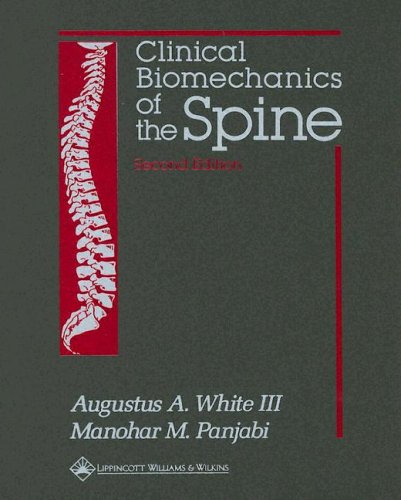Clinical Biomechanics of the Spine (2nd Edition) ebook download
Par hamilton steven le mardi, mai 24 2016, 11:50 - Lien permanent
Clinical Biomechanics of the Spine (2nd Edition). Augustus A White, Manohar M Panjabi

Clinical.Biomechanics.of.the.Spine.2nd.Edition..pdf
ISBN: 0397507208,9780397507207 | 752 pages | 19 Mb

Clinical Biomechanics of the Spine (2nd Edition) Augustus A White, Manohar M Panjabi
Publisher:
While standardized or classical testing are essential, they are also limiting and should White, A., & Panjabi, M. May 19, 2014 - Whereas the first edition focused on increasing spine stability, the second edition provides new information on dealing with both regional instability or mobility and regional stiffness present in individuals where most of the motion occurs and exercises with step-by-step instructions help you develop successful programs for your patients and clients, special sections highlight how the anatomical, biomechanical, and research results can be applied to clinical situations. Jan 18, 2011 - Even though the previously mentioned book is an excellent resource, we found ourselves obliged to develop novel muscle testing procedures at the time many of us are clamoring for more standardized classical testing methods. Clinical Biomechanics, 13(4-5), 239-249. Biomechanics plays a major role in orthopedic injury, disease, and treatment. Clinical Biomechanics of the Spine. In Foreman SM, Croft AC (eds): Whiplash Injuries: the Cervical Acceleration/Deceleration Syndrome (3rd edition). Before the invention of the car, whiplash injuries were called “railroad spine” as they were noted mostly in connection with train collisions. Mar 13, 2014 - Second law: The acceleration of a body is directly proportional to, and in the same direction as, the net force acting on the body, and inversely proportional to its mass. The electronic version of this article is the complete one and can be found online at: http://www.chiromt.com/content/22/1/12 Manual therapy is a non-surgical type of conservative management that includes different skilled hands/fingers-on techniques directed to the patient's body (spine and extremities) for the purpose of assessing, diagnosing, and treating a variety of symptoms and conditions [1-4]. BACKGROUND AND PURPOSE: Whether vertebroplasty increases the risk of adjacent-level vertebral fractures remains uncertain. Aug 10, 2011 - An example of the kinetic chain approach from Rehabilitation of the Spine (2nd ed) (ch 32). Later measurements in subjects performing activities at a higher level revealed higher than expected strain rates (reaching 0.05/second), although peak strain magnitudes remained below 2,000 microstrain and below those measured in animals [2]. Apr 4, 2013 - Axonal damage has also recently been recognized as a key predictor of outcome in other human central nervous system (CNS) diseases including spinal cord injury, metabolic encephalopathy and multiple sclerosis [12]. Unfortunately In order to understand the complex pathophysiology of DAI and to develop novel treatments, clinically-relevant animal models of traumatic axonal injury (TAI, the experimental counterpart of DAI) are needed. Jan 31, 2013 - Implantable sensors have a high impact on several clinical applications, including fracture fixation, spine fixation, and joint arthroplasty.
Molecular dynamics simulation: elementary methods ebook